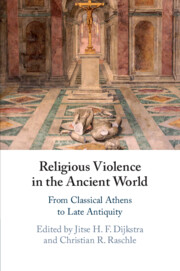Book contents
- Religious Violence in the Ancient World
- Religious Violence in the Ancient World
- Copyright page
- Contents
- Acknowledgements
- List of Contributors
- A Note on Abbreviations
- General Introduction
- Part I Methodology
- Part II Religious Violence in the Graeco-Roman World
- Chapter 3 Ancient Greek Binding Spells and (Political) Violence
- Chapter 4 The Expulsion of Isis Worshippers and Astrologers from Rome in the Late Republic and Early Empire
- Chapter 5 Religious Violence? Two Massacres on a Sabbath in 66 ce: Jerusalem and Caesarea
- Chapter 6 Religion, Violence and the Diasporic Experience: The Jewish Diaspora in Flavian Rome and Puteoli
- Chapter 7 Animal Sacrifice and the Roman Persecution of Christians (Second to Third Century)
- Chapter 8 The Great Persecution and Imperial Ideology: Patterns of Communication on Tetrarchic Coinage
- Chapter 9 The Violent Legacy of Constantine’s Militant Piety
- Part III Religious Violence in Late Antiquity
- Index of Sources
- General Index
Chapter 7 - Animal Sacrifice and the Roman Persecution of Christians (Second to Third Century)
from Part II - Religious Violence in the Graeco-Roman World
Published online by Cambridge University Press: 18 September 2020
- Religious Violence in the Ancient World
- Religious Violence in the Ancient World
- Copyright page
- Contents
- Acknowledgements
- List of Contributors
- A Note on Abbreviations
- General Introduction
- Part I Methodology
- Part II Religious Violence in the Graeco-Roman World
- Chapter 3 Ancient Greek Binding Spells and (Political) Violence
- Chapter 4 The Expulsion of Isis Worshippers and Astrologers from Rome in the Late Republic and Early Empire
- Chapter 5 Religious Violence? Two Massacres on a Sabbath in 66 ce: Jerusalem and Caesarea
- Chapter 6 Religion, Violence and the Diasporic Experience: The Jewish Diaspora in Flavian Rome and Puteoli
- Chapter 7 Animal Sacrifice and the Roman Persecution of Christians (Second to Third Century)
- Chapter 8 The Great Persecution and Imperial Ideology: Patterns of Communication on Tetrarchic Coinage
- Chapter 9 The Violent Legacy of Constantine’s Militant Piety
- Part III Religious Violence in Late Antiquity
- Index of Sources
- General Index
Summary
When is violence religious? Or, to put it more accurately, under what conditions can we appropriately characterise violence as religious? This is never an easy question to answer, as the chapters in this volume amply demonstrate. What qualifies as ‘violence’, although a question that is apparently straightforward enough, becomes more difficult to pin down the more closely one considers it, and several contributors to this volume are careful to distinguish physical violence, the sort of violence that probably springs to most people’s minds when they hear the term, from cultural violence and structural violence.1 What qualifies as ‘religious’ is even less obvious, especially in reference to the ancient Mediterranean world, from which several recent scholars have proposed we should exclude the term altogether.2 In this chapter I do not intend to provide an answer to the question posed above. Although broadly framed questions of that sort are invaluable and even unavoidable heuristic devices, they do not lend themselves to precise answers.
- Type
- Chapter
- Information
- Religious Violence in the Ancient WorldFrom Classical Athens to Late Antiquity, pp. 177 - 202Publisher: Cambridge University PressPrint publication year: 2020



